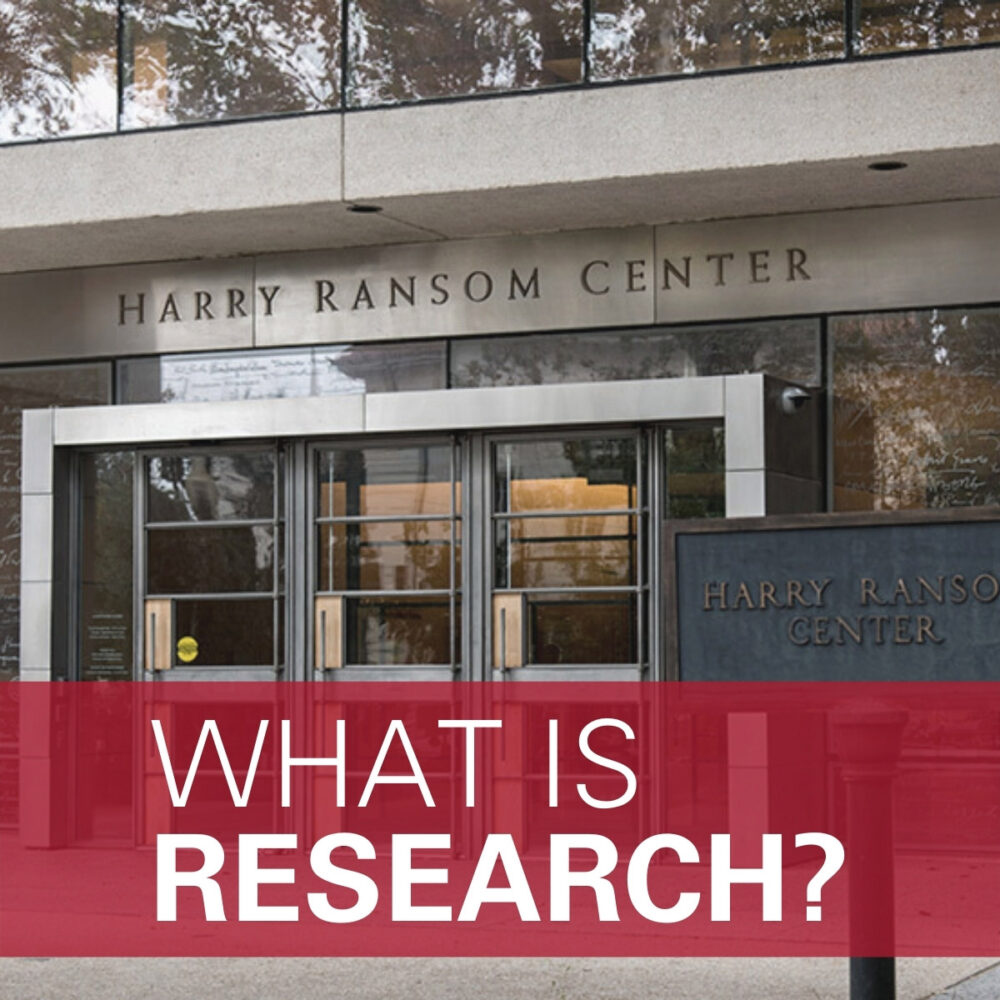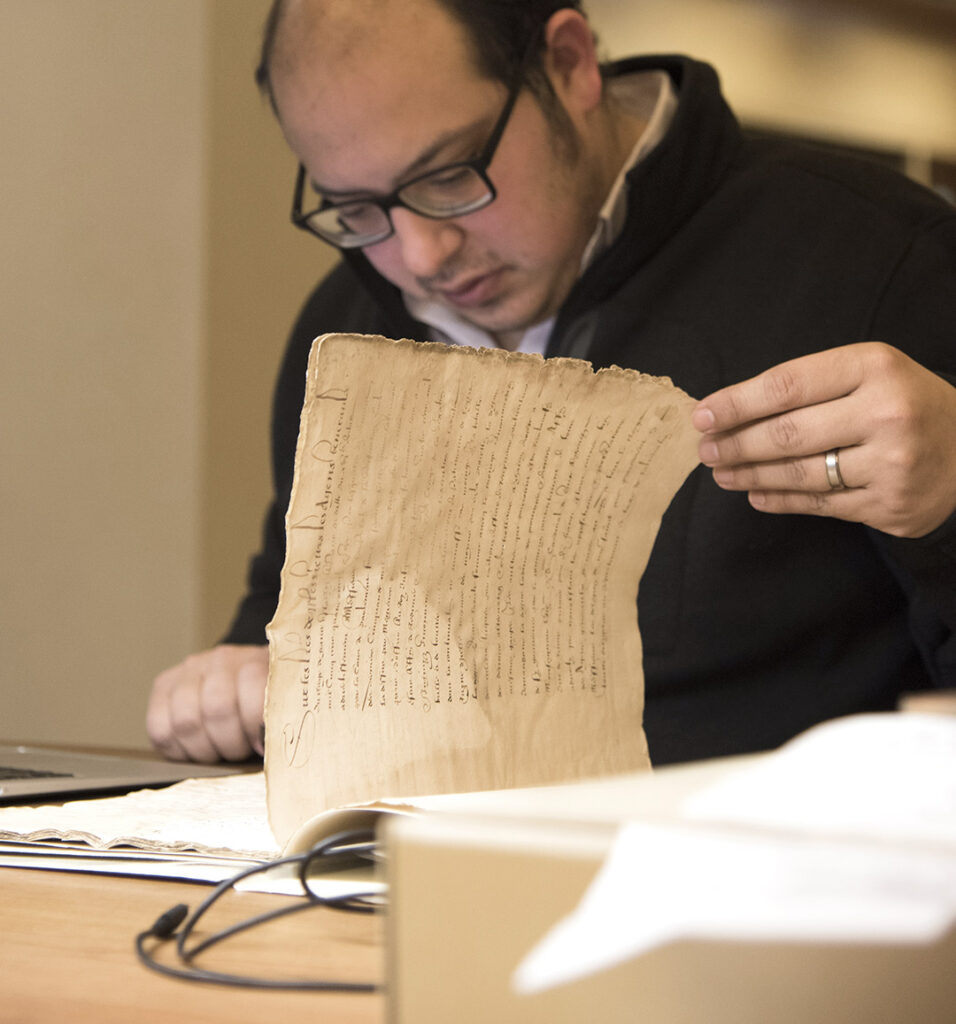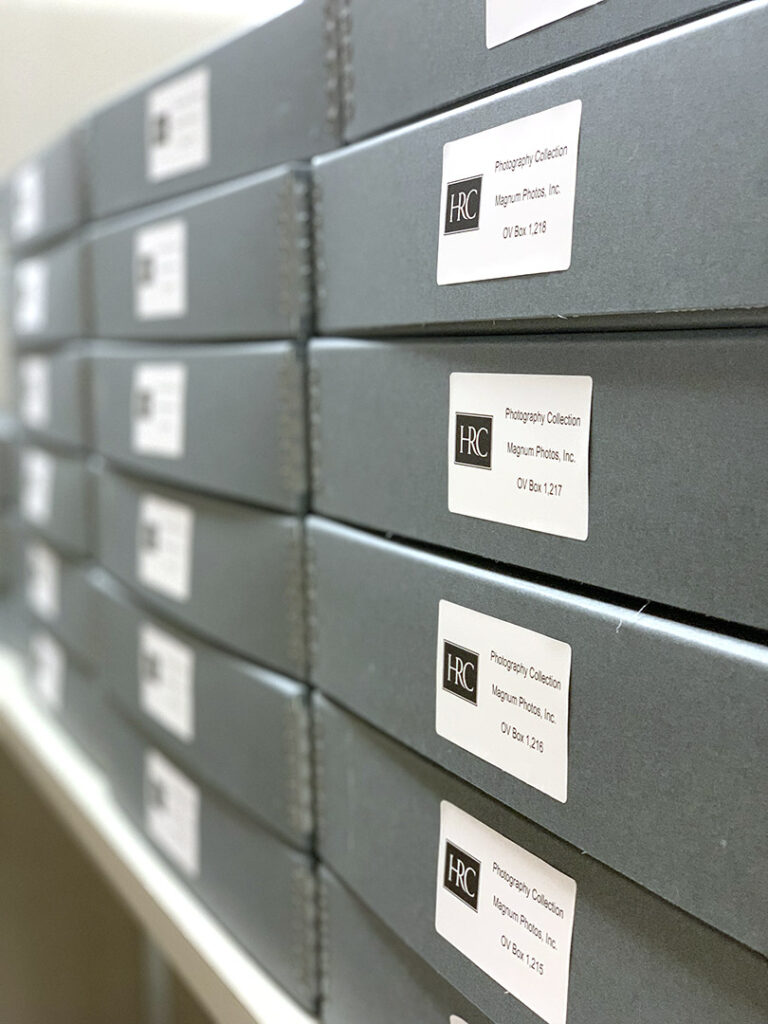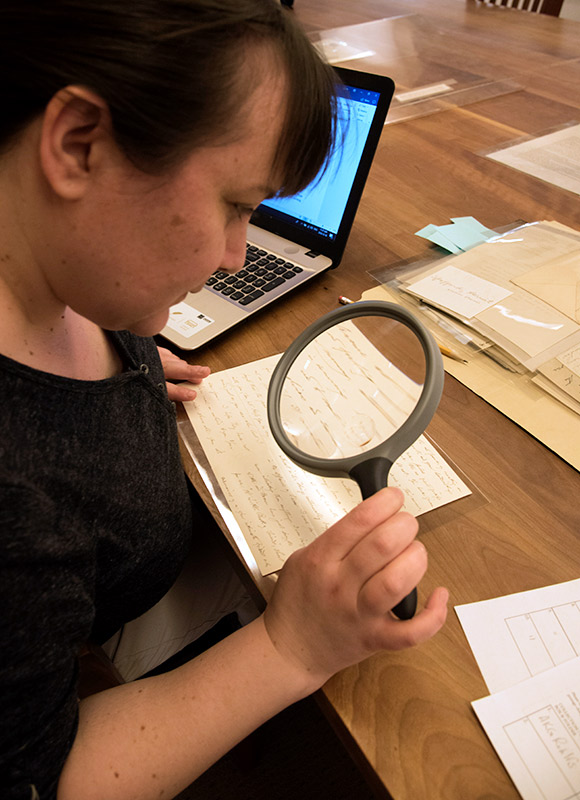
by JIM KUHN
This essay is part of a slow research series, What is Research?
The Harry Ransom Center’s “What Is Research” project ran from 2019-2020. The corresponding “DARE To Research” award was a one-time activity, funded at that time by the University of Texas at Austin Division of Diversity and Community Engagement.
The Harry Ransom Center’s collections are vast. Constantly growing with new acquisitions, our holdings include nearly 1 million books, more than 42 million manuscripts, 5 million photographs, and 100,000 works of art. When an item enters our collections, many activities need to happen before a researcher can encounter that material, before it is paged to the reading and viewing room, or before reference images can be provided as digital surrogates.
Although nearly all of the Ransom Center’s collections are open for research, regardless of cataloging status, not all collections are easy to find. Because materials are stewarded as special collections in closed stacks, they require degrees of staff facilitation for different levels of use by students, instructors, researchers, and visitors to exhibitions and public programs.[1] Our work is dedicated to finding innovative ways to make these vast collections accessible, so researchers, faculty, students, and the public can find what they seek—or perhaps even better, discover something more than what they hoped to find.

To enable this access and discovery, the Center’s team of archivists, catalogers, curators, conservators, exhibition professionals, and many others dedicate considerable attention and time immersed in the collections and their critical and creative contexts. From the moment a collection arrives until it is “reading and viewing room ready,” and beyond, items are closely and methodically inspected by highly trained individuals with a variety of specialized skill sets and across multiple departments.
These processes start even before an item’s initial acquisition through research and correspondences, often stretching over years. Then comes a collection’s arrival, sometimes from a great distance, followed by the careful inspection of each item’s condition (a process that Center conservators cheerfully refer to as the “bug and mold check”), accessioning, processing, housing, cataloging, interpretation, and more. Processes need to be sensitive to differences like type of material and size. Some acquisitions consist of a single object, book, or archival folder; others can take up to hundreds of linear feet of shelf space. Levels and types of descriptive access vary as well.

Through my work directing the Library Division, I am mindful of how many layers of work support research services. Whether a researcher seeks to work with a fully cataloged book or art object or with an archival collection that is fully-processed, described only by a preliminary inventory, or with material for which we as-of-yet have only limited information, some level of staff involvement takes place. Research-based staff work like this happens behind the scenes, relatively invisible, yet essential. Without this mediation, a researcher would have difficulty finding items through a basic library catalog search or archival finding aid search, or forming questions to ask our reference staff while seeking materials of use.
These necessary interventions are most frequently extremely helpful and connective; yet simultaneously, library processes themselves can contribute to potential barriers to research. As Associate Director for Research Gretchen Henderson said in her essay launching this What Is Research? Forum:
“Libraries, museums, and universities are undeniably entangled. Their classification systems have developed alongside histories of colonization, with erasures of Indigenous and other knowledges. Appreciating the many contributions of higher education, it seems important to acknowledge that institutional structures and disciplinary practices have also reinforced some divisions and inequities. Like everywhere, the Ransom Center has grown up within and contributes to this sociocultural history.”[2]

Individual and institutional mediation—in all its multiple and often invisible ways—is something that we should each be encouraged to think beyond, so that research and access activities can proceed both because of and in spite of the interventions that necessarily stand between collection and researcher. The Ransom Center’s new invitation to DARE (Diversity Awards for Research Engagement) is just one step that we are taking to help to bridge what might, in some situations and times and with some collections, seem a daunting gap.
The Diversity Awards for Research Engagement (DARE) of up to $1,000 will be awarded to submissions to the What is Research? Forum that presents innovative research in support of diversity, equity, inclusion, and accessibility. (Deadline March 1, 2021; earlier submission is encouraged.) We invite scholars, practitioners, and creatives both from in and outside The University of Texas at Austin to highlight underutilized collections in the Ransom Center related to underrepresented communities through an open submission. DARE Awards will be granted in multiple categories: faculty (including contingent faculty), students, staff, and outside researchers (including current and former fellows). We hope this series will showcase more diversity in research, ask new questions of our collections and practices, and provide pathways for new researchers to engage with and grow the Ransom Center community. Some submitted essays are already being published in the Ransom Center Magazine Online; in addition to the cash awards, selected participants may be invited to engage in a public conversation on research.
These awards are generously sponsored by the University’s Vice Provost for Diversity, Senior Vice Provost for Academic Affairs, Senior Vice President/Chief Financial Officer, and Vice President for Research.
Since its earliest years the Center has acquired work by women, BIPOC, and LGBTQIA+ creators. As former Graduate Student Associates Diana Silveira Leite and Gaila Sims pointed out in their What Is Research piece, the James Baldwin Go Tell It On The Mountain papers were acquired in 1960.[3] This is the same year that the Radclyffe Hall and Una Troubridge papers were first acquired.[4] In recent years, the Ransom Center has both continued to acquire and made concerted efforts to provide new and improved access to diverse collections.[5] And we are committed to doing better. Even as the Center’s staff work to recognize and embrace our complex responsibilities to advance understanding of the humanities for a broad and diverse audience, we seek new ways to facilitate spaces where people can share their voices and interpretations of collections and of topics that have historically been underrepresented in collecting, in cataloging and digitization, in research and teaching, and in scholarship and creative practice.
Research-based staff work like this happens behind the scenes, relatively invisible, yet essential. Without this mediation, a researcher would have difficulty finding items through basic library catalog or archival finding aid searches, or forming questions to ask our reference staff while seeking materials. These necessary interventions are most frequently extremely helpful and connective; yet simultaneously, library processes themselves can contribute to potential barriers to research.
—JIM KUHN
All of these institutional actions are forms of slow research, of classification, of structuring imposed on the creative endeavor. These systems and activities are historically and in the present neither neutral, nor immune to critique. Those of us who have been engaged with, and who have inherited these essential activities from the over 60 years since the Center’s founding, inevitably have our own implicit biases, with often unconscious or unacknowledged attitudes and stereotypes. Over the Center’s history, many personal histories have been built into the layers and processes around our collections and institutional practices, which we are actively working to disentangle and to collectively reconstruct.

In 2020, the ACRL (Association of College and Research Libraries) published a revised Code of Ethics for Special Collections Librarians, reinvigorating the professional mission:
“As stewards of the cultural record, practitioners also bear a responsibility to represent historically underrepresented and marginalized voices, recognizing that diversity is complex and intersectional, and that silences, gaps, and poor description resulting from historical biases have the potential to do great harm.”[6]
As an institution founded the year that the University undergraduate class was finally desegregated in 1957, the Harry Ransom Center recognizes DARE as just one step we can take now, together, to help forge what the Provost’s Office has referred to as “an inclusive environment of teaching, research, and service in which all can learn from one another, productively interact, and share in the benefits of learning and working at a diverse university.”[7]
Entrants who DARE to share their research will help us grow a sense of the Ransom Center as a living library, as we try to better understand and facilitate engagements with our collections, both of their pasts (including how they came to be acquired, described, and interpreted) but also their potential futures. As we seek innovative ways to make them more accessible and open to new interpretations, we hope to discover more than what we set out to find.
[1] The “ACRL-RBMS/SAA Guidelines on Access to Research Materials in Archives and Special Collections Libraries, 2020” provide an important “advocacy tool and foundation for policies and procedures to facilitate equitable access to resources and services.”
[2] Gretchen Henderson, “What is Research? An exercise in Slow Research,” Ransom Center Magazine Online, 09/05/2020.
[3] Diana Silveira Leite and Gaila Sims, “Curating ‘Fugitive Findings’ and the right to research slowly,” Ransom Center Magazine Online, 10/28/2020.
[4] Radclyffe Hall and Una Vincenzo, Lady Troubridge Papers (Manuscript Collection MS-01793), Harry Ransom Center, The University of Texas at Austin.
[5] The last twelve months of new and substantially revised finding aids call always be found at our New and Revised Finding Aids list.
[6] Association of College and Research Libraries, Code of Ethics for Special Collections Librarians, 2020.
[7] University of Texas at Austin Office of the Vice President and Provost, “Embracing diversity in all forms,” 2020.